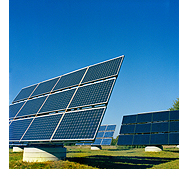|
||||||||||||||
| Alternative
sources In contrast to the fossil fuel based generation of power, we have an increasing range of “alternative” energies from nuclear through to the so-called bio energy, renewable, sustainable and green energy. These terms can be misleading and sometimes even controversial. This section considers the alternatives in terms of the original energy source type which can be divided into nuclear, chemical, thermal, photo (light) and kinetic (motion) and potential (position). Notice many use the heat-kinetic energy route in order to exploit the classic turbine and generator combination.
 These
alternative sources are clearly very dependent on the Law of conservation
of energy and appear to be sustainable but in other respects are quite diverse.
In particular many being exclusively physical produce no chemical pollutants,
though nuclear poses different issues with long half-life and containment
of decay products. Many of the above, like classic generation from fossil
fuels however, suffer from relatively low efficiencies and thus offer scope
for innovation and developments which retain the basic design but improve
the output. Where the energy source is natural, particularly weather related,
consistency is another major problem, requiring methods to store energy
when it is produced but not needed and release it when needed but not being
produced. This too is an area where new developments are having a big impact. These
alternative sources are clearly very dependent on the Law of conservation
of energy and appear to be sustainable but in other respects are quite diverse.
In particular many being exclusively physical produce no chemical pollutants,
though nuclear poses different issues with long half-life and containment
of decay products. Many of the above, like classic generation from fossil
fuels however, suffer from relatively low efficiencies and thus offer scope
for innovation and developments which retain the basic design but improve
the output. Where the energy source is natural, particularly weather related,
consistency is another major problem, requiring methods to store energy
when it is produced but not needed and release it when needed but not being
produced. This too is an area where new developments are having a big impact.Recent developments have taken the theme of better use of existing sources and production e.g. in processing general refuse, meat processing waste and in extracting more usable energy from existing processes (waste heat) e.g. power stations. The idea of alternative energy sources has raised an important further consideration – the reduction of energy consumption. The media and government have been accused of promoting the use of energy albeit from greener sources at the expense of focusing on energy reduction and this should not be overlooked in the overall developments following the Stern Review. It is also interesting that to date a key indicator of a developed nation has been its capacity to generate and perhaps more significantly to use energy. |
||||||||||||||||||||||||||||||||||||||||||||||||||||